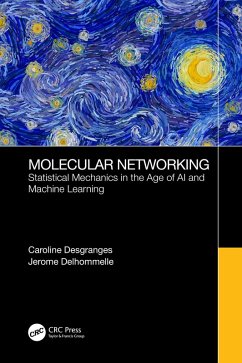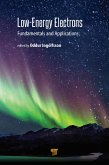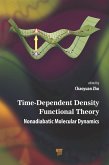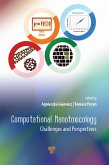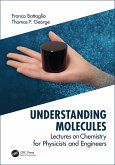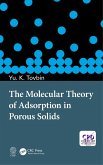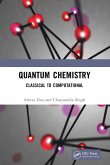Molecular Networking (eBook, ePUB)
Statistical Mechanics in the Age of AI and Machine Learning


Alle Infos zum eBook verschenken

Molecular Networking (eBook, ePUB)
Statistical Mechanics in the Age of AI and Machine Learning
- Format: ePub
- Merkliste
- Auf die Merkliste
- Bewerten Bewerten
- Teilen
- Produkt teilen
- Produkterinnerung
- Produkterinnerung

Hier können Sie sich einloggen

Bitte loggen Sie sich zunächst in Ihr Kundenkonto ein oder registrieren Sie sich bei bücher.de, um das eBook-Abo tolino select nutzen zu können.
The book builds on the analogy between social groups and assemblies of molecules to introduce the concepts of statistical mechanics, machine learning and data science. Applying a data analytics approach to molecular systems, we show how individual (molecular) features and interactions between molecules, or "communication" processes, allow for the prediction of properties and collective behavior of molecular systems - just as polling and social networking shed light on the behavior of social groups. Applications to systems at the cutting-edge of research for biological, environmental, and…mehr
- Geräte: eReader
- mit Kopierschutz
- eBook Hilfe
![Low-Energy Electrons (eBook, ePUB) Low-Energy Electrons (eBook, ePUB)]() Low-Energy Electrons (eBook, ePUB)136,95 €
Low-Energy Electrons (eBook, ePUB)136,95 €![Time-Dependent Density Functional Theory (eBook, ePUB) Time-Dependent Density Functional Theory (eBook, ePUB)]() Time-Dependent Density Functional Theory (eBook, ePUB)151,95 €
Time-Dependent Density Functional Theory (eBook, ePUB)151,95 €![Quantum Theory of Transport Properties of Single Molecules (eBook, ePUB) Quantum Theory of Transport Properties of Single Molecules (eBook, ePUB)]() Yoshihiro AsaiQuantum Theory of Transport Properties of Single Molecules (eBook, ePUB)189,95 €
Yoshihiro AsaiQuantum Theory of Transport Properties of Single Molecules (eBook, ePUB)189,95 €![Computational Nanotoxicology (eBook, ePUB) Computational Nanotoxicology (eBook, ePUB)]() Computational Nanotoxicology (eBook, ePUB)151,95 €
Computational Nanotoxicology (eBook, ePUB)151,95 €![Understanding Molecules (eBook, ePUB) Understanding Molecules (eBook, ePUB)]() Franco BattagliaUnderstanding Molecules (eBook, ePUB)46,95 €
Franco BattagliaUnderstanding Molecules (eBook, ePUB)46,95 €![The Molecular Theory of Adsorption in Porous Solids (eBook, ePUB) The Molecular Theory of Adsorption in Porous Solids (eBook, ePUB)]() Yu. K. TovbinThe Molecular Theory of Adsorption in Porous Solids (eBook, ePUB)46,95 €
Yu. K. TovbinThe Molecular Theory of Adsorption in Porous Solids (eBook, ePUB)46,95 €![Quantum Chemistry (eBook, ePUB) Quantum Chemistry (eBook, ePUB)]() Amita DuaQuantum Chemistry (eBook, ePUB)162,95 €
Amita DuaQuantum Chemistry (eBook, ePUB)162,95 €-
-
-
Key features:
- Draws on a data analytics approach of molecular systems
- Covers hot topics such as artificial intelligence and machine learning of molecular trends
- Contains applications to systems at the cutting-edge of research for biological, environmental and energy applications
- Discusses molecular simulation and links with other important, emerging techniques and trends in computational sciences and society
- Authors have a well-established track record and reputation in the field
Dieser Download kann aus rechtlichen Gründen nur mit Rechnungsadresse in A, B, BG, CY, CZ, D, DK, EW, E, FIN, F, GR, HR, H, IRL, I, LT, L, LR, M, NL, PL, P, R, S, SLO, SK ausgeliefert werden.
- Produktdetails
- Verlag: Taylor & Francis eBooks
- Seitenzahl: 248
- Erscheinungstermin: 29. Januar 2024
- Englisch
- ISBN-13: 9781003832560
- Artikelnr.: 69638390
- Verlag: Taylor & Francis eBooks
- Seitenzahl: 248
- Erscheinungstermin: 29. Januar 2024
- Englisch
- ISBN-13: 9781003832560
- Artikelnr.: 69638390
- Herstellerkennzeichnung Die Herstellerinformationen sind derzeit nicht verfügbar.
Dr. Jerome Delhommelle did his undergraduate studies at the Ecole Normale Superieure Paris-Saclay and received his PhD in Chemistry from the University of Paris-Saclay (France) in 2000. He is currently an Associate Professor in Chemistry at the University of Massachusetts Lowell.
, P,R) Ensemble 7.2.3 A Full Picture for the Four Adiabatic Ensembles 7.3 MONTE CARLO EXPLORATION OF ADIABATIC ENSEMBLES 7.3.1 Exploring the Microcanonical Ensemble 7.3.2 Musing in the (N, P,H) Ensemble 7.3.3 Direct Entropy Evaluations in the (
, P,R) Ensemble Chapter 8 Networking under one (or more) cues: isothermal ensembles 8.1 THERMAL AND CHEMICAL CUES 8.1.1 The Grand-Canonical Ensemble 8.1.2 Monte Carlo Exploration 8.1.3 Grand Partition Function Determination 8.2 THERMAL AND MECHANICAL CUES 8.2.1 The Isothermal-Isobaric Ensemble 8.2.2 Properties Calculations 8.2.3 Partition Function Computation 8.3 VARIATIONS AND APPLICATIONS 8.3.1 Multi-Component Systems and Semi-Grand Approach 8.3.2 A First Step towards Coexistence: Gibbs Ensemble Monte Carlo method 8.3.3 Recycling and Reweighting Chapter 9 Collective properties from partition functions 9.1 GENERATING DATA ON PARTITION FUNCTIONS 9.1.1 Starting from A 9.1.2 From dilute to condensed phases 9.1.3 Direct determination of partition functions 9.2 THE CASE OF PHASE TRANSITIONS 9.2.1 Matching Probabilities 9.2.2 Features of coexistence 9.2.3 Extension to Multi-Component Systems 9.3 GAS STORAGE AND SEPARATION APPLICATIONS 9.3.1 Partition Functions for Adsorbed Fluids 9.3.2 Thermodynamic Properties of Adsorption 9.3.3 Environmental and Energy Applications Chapter 10 Machine Learning Molecular Trends 10.1 LEARNING INTERMOLECULAR INTERACTIONS 10.1.1 Starting from empirical datasets 10.1.2 Training on tight-binding data 10.1.3 Neural network potentials 10.2 LEARNING PARTITION FUNCTIONS 10.2.1 Single-component systems 10.2.2 Multicomponent mixtures 10.2.3 Adsorbed Phases 10.3 LEARNING TRANSITIONS 10.3.1 Spanning Pathways 10.3.2 From Partition Functions to Reaction Coordinates 10.3.3 On-The-Fly Learning of Collective Variables Section III Dynamic trends: motion statistics Chapter 11 Molecular evolution and fluctuations: time-resolved statistics 11.1 COMPUTING MOLECULAR TRAJECTORIES 11.1.1 Ensemble and Time Averages Equivalency 11.1.2 Molecular Equations of Motion 11.1.3 Integration Schemes 11.2 MOLECULAR TRAJECTORIES 11.2.1 Gauss' principle of least constraint 11.2.2 Keeping the temperature in check 11.2.3 Nos
e-Hoover Thermostat 11.3 MULTIPLE-TIME STEPS AND HYBRID SCHEMES 11.3.1 Time-splitting 11.3.2 Controlling pressure 11.3.3 Hybrid schemes Chapter 12 Noise and information: correlation functions 12.1 MOTION AND TRANSPORT 12.1.1 Brownian Motion 12.1.2 Langevin Equation & Fluctuation-Dissipation 12.1.3 Einstein Diffusion Equation 12.2 TRANSPORT FROM CORRELATION 12.2.1 D from a Correlation Function 12.2.2 The Mori-Zwanzig approach 12.2.3 Evaluation of Transport Coefficients 12.3 RESPONSE THEORY 12.3.1 Linear response theory 12.3.2 Time-Dependent Linear Response 12.3.3 Nonlinear Response, Dynamical Stability, and Chaos Chapter 13 External fields and agents: new communication paradigms 13.1 NONEQUILIBRIUM MOLECULAR TRAJECTORIES 13.1.1 Boundary-Driven and Synthetic Setups 13.1.2 Accounting for Heat Dissipation 13.1.3 Extracting Transport Coefficients 13.2 COMPUTING NONEQUILIBRIUM TRAJECTORIES 13.2.1 Physical Boundaries vs Periodic Boundaries 13.2.2 Nonequilibrium Definitions for Temperature 13.2.3 Transport in the Steady-State 13.3 TRANSIENT-TIME CORRELATION FUNCTION 13.3.1 Formalism 13.3.2 Bridging between Equilibrium and Nonequilibrium 13.3.3 Transport close(r) to Equilibrium Chapter 14 Fluctuation Theorems, Molecular Machines and Emergent Behavior in Active Matter 14.1 FLUCTUATION THEOREMS 14.1.1 Formalism 14.1.2 Negative Entropy Production Trajectories 14.1.3 Free Energy Differences 14.2 TOWARDS A NEW PHYSICS OF LIVING SYSTEMS 14.2.1 Work Relations and RNA Folding 14.2.2 Mutating, stretching, binding, and unbinding 14.2.3 Free energy calculations via steered MD 14.3 EMERGENCE IN ACTIVE MATTER 14.3.1 Dry Active Matter 14.3.2 Active Brownian Matter & MIPS 14.3.3 Entropy Production: from Active Matter to Molecular Machines Chapter 15 Learning evolution and transport 15.1 LEARNING TRANSPORT 15.1.1 Rationale for Diffusion Learning 15.1.2 RNNs and LSTMs in Action 15.1.3 Classifying Diffusion Behaviors 15.2 LEARNING DYNAMICS 15.2.1 Learning Equations of Motion for Mesoscopic and Structured Systems 15.2.2 Learning Differential Equations 15.2.3 Data-Driven Identification of Governing Equations 15.3 LEARNING NAVIGATION 15.3.1 Adapting to the Environment 15.3.2 Identifying Navigation Strategies 15.3.3 Learning Collective Motion
, P,R) Ensemble 7.2.3 A Full Picture for the Four Adiabatic Ensembles 7.3 MONTE CARLO EXPLORATION OF ADIABATIC ENSEMBLES 7.3.1 Exploring the Microcanonical Ensemble 7.3.2 Musing in the (N, P,H) Ensemble 7.3.3 Direct Entropy Evaluations in the (
, P,R) Ensemble Chapter 8 Networking under one (or more) cues: isothermal ensembles 8.1 THERMAL AND CHEMICAL CUES 8.1.1 The Grand-Canonical Ensemble 8.1.2 Monte Carlo Exploration 8.1.3 Grand Partition Function Determination 8.2 THERMAL AND MECHANICAL CUES 8.2.1 The Isothermal-Isobaric Ensemble 8.2.2 Properties Calculations 8.2.3 Partition Function Computation 8.3 VARIATIONS AND APPLICATIONS 8.3.1 Multi-Component Systems and Semi-Grand Approach 8.3.2 A First Step towards Coexistence: Gibbs Ensemble Monte Carlo method 8.3.3 Recycling and Reweighting Chapter 9 Collective properties from partition functions 9.1 GENERATING DATA ON PARTITION FUNCTIONS 9.1.1 Starting from A 9.1.2 From dilute to condensed phases 9.1.3 Direct determination of partition functions 9.2 THE CASE OF PHASE TRANSITIONS 9.2.1 Matching Probabilities 9.2.2 Features of coexistence 9.2.3 Extension to Multi-Component Systems 9.3 GAS STORAGE AND SEPARATION APPLICATIONS 9.3.1 Partition Functions for Adsorbed Fluids 9.3.2 Thermodynamic Properties of Adsorption 9.3.3 Environmental and Energy Applications Chapter 10 Machine Learning Molecular Trends 10.1 LEARNING INTERMOLECULAR INTERACTIONS 10.1.1 Starting from empirical datasets 10.1.2 Training on tight-binding data 10.1.3 Neural network potentials 10.2 LEARNING PARTITION FUNCTIONS 10.2.1 Single-component systems 10.2.2 Multicomponent mixtures 10.2.3 Adsorbed Phases 10.3 LEARNING TRANSITIONS 10.3.1 Spanning Pathways 10.3.2 From Partition Functions to Reaction Coordinates 10.3.3 On-The-Fly Learning of Collective Variables Section III Dynamic trends: motion statistics Chapter 11 Molecular evolution and fluctuations: time-resolved statistics 11.1 COMPUTING MOLECULAR TRAJECTORIES 11.1.1 Ensemble and Time Averages Equivalency 11.1.2 Molecular Equations of Motion 11.1.3 Integration Schemes 11.2 MOLECULAR TRAJECTORIES 11.2.1 Gauss' principle of least constraint 11.2.2 Keeping the temperature in check 11.2.3 Nos
e-Hoover Thermostat 11.3 MULTIPLE-TIME STEPS AND HYBRID SCHEMES 11.3.1 Time-splitting 11.3.2 Controlling pressure 11.3.3 Hybrid schemes Chapter 12 Noise and information: correlation functions 12.1 MOTION AND TRANSPORT 12.1.1 Brownian Motion 12.1.2 Langevin Equation & Fluctuation-Dissipation 12.1.3 Einstein Diffusion Equation 12.2 TRANSPORT FROM CORRELATION 12.2.1 D from a Correlation Function 12.2.2 The Mori-Zwanzig approach 12.2.3 Evaluation of Transport Coefficients 12.3 RESPONSE THEORY 12.3.1 Linear response theory 12.3.2 Time-Dependent Linear Response 12.3.3 Nonlinear Response, Dynamical Stability, and Chaos Chapter 13 External fields and agents: new communication paradigms 13.1 NONEQUILIBRIUM MOLECULAR TRAJECTORIES 13.1.1 Boundary-Driven and Synthetic Setups 13.1.2 Accounting for Heat Dissipation 13.1.3 Extracting Transport Coefficients 13.2 COMPUTING NONEQUILIBRIUM TRAJECTORIES 13.2.1 Physical Boundaries vs Periodic Boundaries 13.2.2 Nonequilibrium Definitions for Temperature 13.2.3 Transport in the Steady-State 13.3 TRANSIENT-TIME CORRELATION FUNCTION 13.3.1 Formalism 13.3.2 Bridging between Equilibrium and Nonequilibrium 13.3.3 Transport close(r) to Equilibrium Chapter 14 Fluctuation Theorems, Molecular Machines and Emergent Behavior in Active Matter 14.1 FLUCTUATION THEOREMS 14.1.1 Formalism 14.1.2 Negative Entropy Production Trajectories 14.1.3 Free Energy Differences 14.2 TOWARDS A NEW PHYSICS OF LIVING SYSTEMS 14.2.1 Work Relations and RNA Folding 14.2.2 Mutating, stretching, binding, and unbinding 14.2.3 Free energy calculations via steered MD 14.3 EMERGENCE IN ACTIVE MATTER 14.3.1 Dry Active Matter 14.3.2 Active Brownian Matter & MIPS 14.3.3 Entropy Production: from Active Matter to Molecular Machines Chapter 15 Learning evolution and transport 15.1 LEARNING TRANSPORT 15.1.1 Rationale for Diffusion Learning 15.1.2 RNNs and LSTMs in Action 15.1.3 Classifying Diffusion Behaviors 15.2 LEARNING DYNAMICS 15.2.1 Learning Equations of Motion for Mesoscopic and Structured Systems 15.2.2 Learning Differential Equations 15.2.3 Data-Driven Identification of Governing Equations 15.3 LEARNING NAVIGATION 15.3.1 Adapting to the Environment 15.3.2 Identifying Navigation Strategies 15.3.3 Learning Collective Motion
